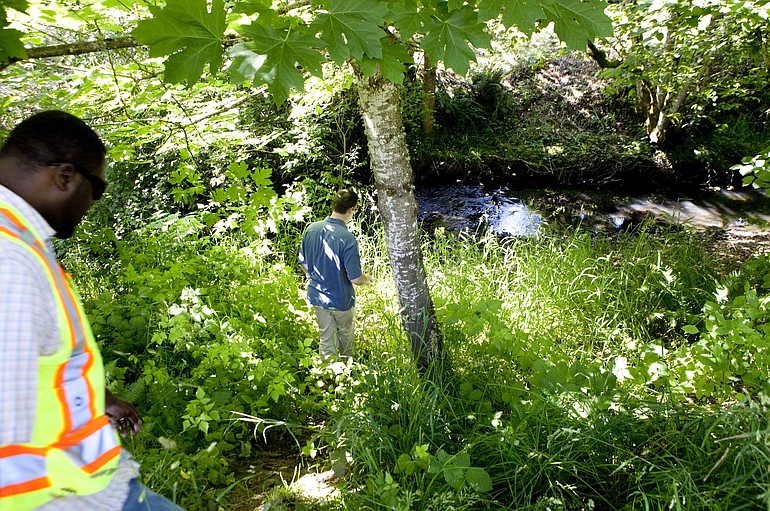Jeff Wittler crouched over Mill Creek, dipping his hand into the water.
He rubbed the rocks of the creek bed, kicking up loose sediment that had settled on top of them. A brown cloud formed around his hand.
Wittler looked up.
“In a healthy system, you don’t see a lot of that,” said Wittler, environmental resources manager for Clark Public Utilities.
And this part of Mill Creek, just above its confluence with Salmon Creek?
“It’s pretty unhealthy.”
To Wittler’s right was one of the culprits: a vertical bank several feet high, undercut by years of erosion. That’s a trend the utility and Washington State University’s Vancouver staff hope to change with a renewed focus on habitat restoration on Mill Creek, which flows through campus. The two partners are in the midst of prep work on the site — with the help of an army of volunteers and community events — before restoration and bank stabilization is set to begin in earnest this fall.
Compared to what university staff first envisioned, “what we ended up doing was a much larger thing,” said James Martin, facilities operations director at WSU-Vancouver.
Mill Creek has long been a focus of university crews, but their efforts ramped up when Clark Public Utilities joined this year. Behind the strength of a $250,000 state grant, the utility’s StreamTeam program will help the campus control invasive species, replant native vegetation and stabilize stream banks to prevent erosion.
All of that follows the campus’ earning “Salmon-Safe” certification last year for its environmental work.
“It’s just gained so much momentum in the past few years,” Martin said.
The team’s main focus this year is a section of Mill Creek just north of Northeast Salmon Creek Avenue, where it flows near a university-owned storage barn on what used to be farmland. Crews started this spring by removing invasive Himalayan blackberry plants along the creek, then planting native trees such as maple, Oregon ash and cedar. Workers will have to keep those blackberry plants at bay to prevent them from choking the young trees.
“We’ll probably be fighting blackberries for a while,” Wittler said.
For early plantings and maintenance, volunteers have spanned a wide spectrum, Martin said, from alumni and local residents to students. Many have come through community events.
Wittler hopes the heavier work of bank stabilization will begin this fall. Much of that comes from planting, he said, and letting roots take hold of the soil. Workers may also use “root wads” of felled trees brought from other development sites, Wittler said. That braces the bank and slows erosion while new roots grow, he said. Coir fabric made from coconut fibers is another option, he said.
“We won’t leave anything in the system that’s not either biodegradable or native to the system,” Wittler said.
Clark Public Utilities won’t use its entire grant for Mill Creek, Wittler said — only about 70 percent of the project is funded by the state Department of Ecology’s clean water grant. Other funding comes from the utility’s budget. Volunteers also chip in plenty of hours.
Habitat restoration is a multiyear process, and fish counts may provide a good measuring stick for the effort’s success, Martin said. Some wild fish, including steelhead, do make their way up Mill Creek past the WSU campus today, Wittler said. But not many.




